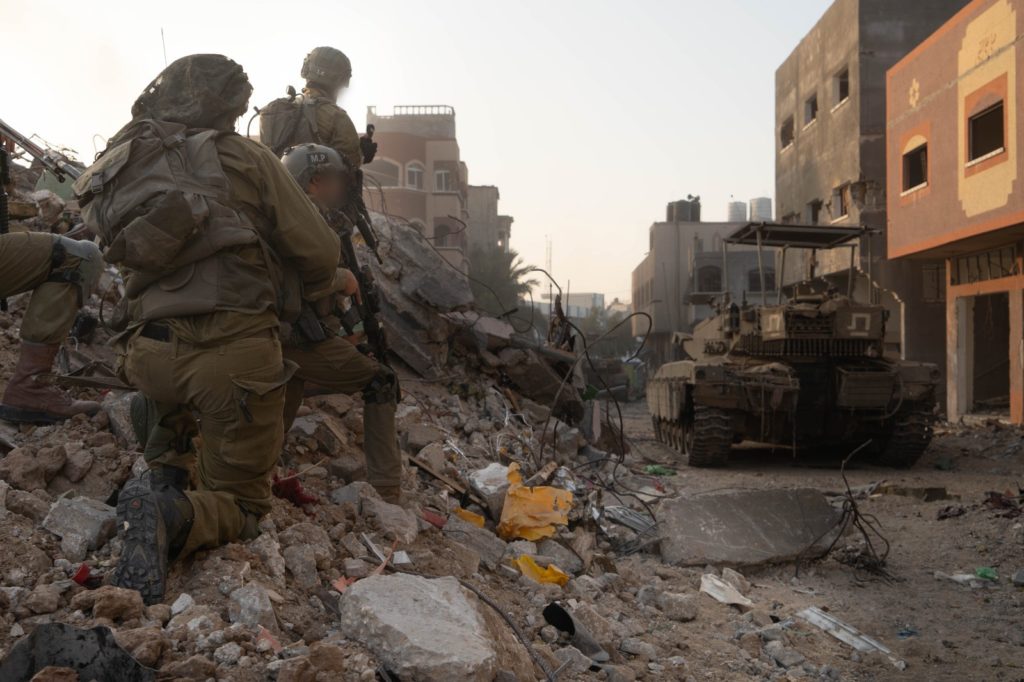Australia/Israel Review
With the 36th Division in Shejaia
Dec 20, 2023 | Jonathan Spyer

“What you can see before you is the destruction of Hamas infrastructure,” Col. Oded Adani tells us as we look toward a row of ruined buildings. “Every building that received fire is one in which we located terrorists. It’s hard fighting, but we’re here and we’re going to destroy them. That’s the mission.”
Adani is the deputy commander of the IDF’s 188 Armoured Brigade, which is part of the 36th Division. The division is currently tasked with the conquest of the Shejaia neighbourhood, one of the centres of support for Hamas in the Strip, and a vital node in the mission of destroying Hamas authority in Gaza.
This week, I spent an afternoon in the company of the 36th Division’s fighters in Shejaia as they continued the slow, methodical work of clearing out Islamist gunmen and their infrastructure from the neighbourhood.
As we speak to Adani, a line of the division’s M109 Howitzers next to us is laying down fire at buildings about two hundred metres away. We shelter behind a ruined house. Between the loud thumps of the 155mm cannons, the commander describes a hard, gruelling fight against a dug-in, well-prepared and resourceful enemy.
“The main challenge is that the enemy hides, and then arrives by surprise, setting traps and making use of civilian infrastructure – schools, cemeteries, and so on. So, a building from which a terrorist emerges gets destroyed.
“There isn’t a building where there isn’t weaponry. There isn’t a school from which terrorists don’t emerge. We see it. So, we’re developing new techniques, finding ourselves anew each day.”
Not the first time around
The 36th Division and the 188 Brigade have a long history in Israel’s wars. It was this division that stopped the Syrian advance on the Golan Heights in 1973. Now, 50 years on, it is fighting a very different war, at a similar moment of crisis for Israel.
I have something of a long history of my own with these units. I served with the 188 Brigade and the 36th Division as a young immigrant lone soldier 30 years ago, in Hebron, Lebanon, and northern Gaza. Now, here we are again in the Gaza Strip, still facing the same enemies.
The destruction in Shejaia is immense. The troops and tanks of the division are fighting their way across a largely ruined landscape. With the Hamas military capacities tightly woven into the civil infrastructure, it has become impossible to cleanly divide the two.
Further into Shejaia, over the rubble, we enter a warren of alleyways and half-demolished buildings. Here, the infantry and armoured elements of the 36th are carrying out their painstaking work of cleansing the area of Hamas presence. It is a tricky and dangerous task.
“Most of Hamas’s infrastructure is based on schools, mosques, hospitals, international structures of various kinds,” Lt.-Col. Tal Tourjeman, commander of the 906th Infantry Battalion, says.
“We find ammunition boxes hidden under the beds of children, rocket launchers placed outside of kindergartens. Ninety-five percent of the buildings we’ve entered contain military materiel of one kind or another – 95%!
You see this and you understand that you’re fighting an enemy on a very low level, whose only objective is to strike at you at any price, including sacrificing his own people, firing from kindergartens and mosques.”
Tourjeman fought in Shejaia ten years ago, in Operation Protective Edge, with the Golani Reconnaissance company. Now he is back, moving through the same rubble-filled alleyways, this time commanding a battalion from the Infantry Commanders School, attached to the 188.
The process he describes is one of methodical pace, careful targeting, and then the application of concentrated, massive force.
“We’re destroying terrorist infrastructures, taking apart the structures that threatened Nahal Oz, Alumim, and Kfar Aza. So that when we’ve left here, not a single terrorist will be able to reach those communities and the civilians that live there.
“We use air power, tanks, drones, all available means, and set out and conquer ground. As a battalion commander, my job is that the soldiers should step over corpses, not to go down to the level of the enemy.”
So, as an old Gaza veteran, has anything surprised Tourjeman about the current iteration of the enemy? The battalion commander replies, with an expression of genuine bewilderment, to the apparent indifference of the Hamas fighters to the lives of their own civilian population.
“They didn’t come to defend the ground, or to preserve a framework of normal life after the fighting is finished. They came to get achievements against us as much as possible, and at any price. The enemy doesn’t hold life sacred. He holds death sacred.”
A few days earlier, the 53rd battalion of the 188 brigade lost three soldiers in northern Gaza – Tuval Sasnani, Eitan Fisch, and Yakir Shinkolevsky. One of our colleagues asked Adani, the 188’s deputy commander, about the losses. I expected the kind of brief, dutiful response that one might get from a commander in the field, weighed down with immediate tasks and responsibilities.
Instead, Adani was silent for a few long seconds. “It’s difficult,” he said. “We’re in touch with the families.” Then he waved his hand and ended the interview.
“In the end, we came to drive out darkness,” Tourjeman told us, by way of conclusion. “Soon, we’ll be marking that. Well, we’re marking it here, too. Physically.”
We left as night was falling, to the inimitable screech and din of armoured tracks on the move. The fight for Shejaia continues.






